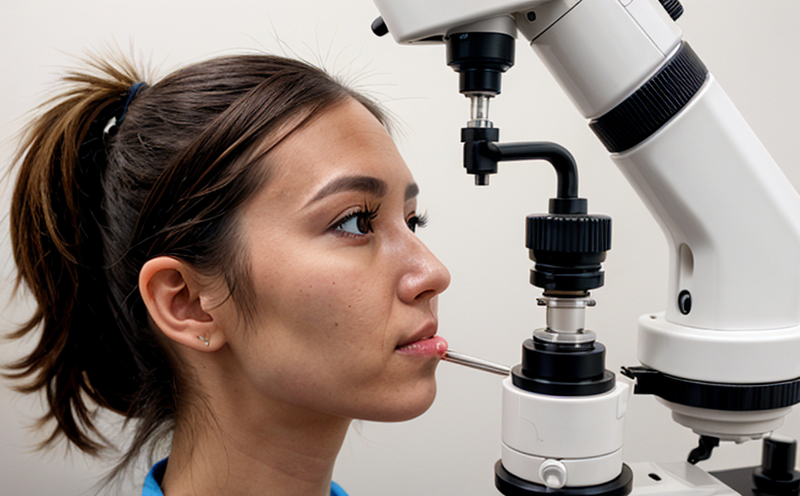ISO 18369-11 Contact Lens Water Content Testing
The ISO 18369 series is a comprehensive set of standards that covers various aspects of contact lenses. Among these, ISO 18369-11 specifically addresses the measurement of water content in contact lenses. This parameter is critical for ensuring product safety and efficacy because it directly influences the lens's comfort, oxygen permeability, and overall performance.
The water content of a contact lens refers to the percentage of water present in the lens relative to its total weight. It is a key factor that affects how the lens interacts with the tear film on the eye. Higher water content can lead to better hydration and improved comfort, but it must be balanced against other properties such as oxygen permeability. Lower water content may result in reduced discomfort but could also reduce the lens's ability to hydrate effectively.
The testing of water content is essential for manufacturers, regulatory bodies, and quality assurance teams. By adhering to ISO 18369-11 standards, laboratories can ensure that their tests are accurate and consistent with international guidelines. This standard provides detailed instructions on how to perform the test under controlled conditions to minimize variability.
Testing typically involves weighing the contact lens before and after exposure to a standardized saline solution for a specified period. The difference in weight is then used to calculate the water content. This process must be conducted using precise analytical balances capable of detecting minute changes in mass. Additionally, temperature and humidity conditions should be strictly controlled during testing.
The importance of this test cannot be overstated, especially given the increasing prevalence of contact lens use worldwide. According to recent statistics, approximately 140 million people globally wear contact lenses daily. Ensuring that these products meet stringent quality standards is paramount for public health and safety.
Compliance with ISO 18369-11 helps manufacturers demonstrate their commitment to producing safe and effective lenses. It also aids in maintaining consumer trust, which is crucial given the sensitive nature of ocular health products. Regulatory bodies like the FDA (Food and Drug Administration) and EMA (European Medicines Agency) often require compliance with such standards as part of their approval processes.
In summary, ISO 18369-11 contact lens water content testing is a vital step in ensuring that contact lenses meet high-quality standards. By adhering to this international standard, laboratories and manufacturers can provide consumers with products they can trust, knowing that rigorous quality controls have been applied throughout the manufacturing process.
Quality and Reliability Assurance
The accuracy of water content measurements is paramount for ensuring product safety. Variations in this parameter can significantly impact user comfort and ocular health.
Water content testing must be conducted under stringent conditions to ensure consistent results across different batches or lots of contact lenses.
For quality managers, compliance officers, R&D engineers, and procurement teams involved in this process, it is essential to understand the importance of precise measurement techniques. Using advanced analytical instruments can help achieve these goals while reducing errors associated with human intervention.
| Test Parameter | Acceptance Criteria |
|---|---|
| Initial Weight of Lens | ±0.05 mg after drying at 60°C for 3 hours. |
| Final Weight After Exposure to Saline Solution | Within ±2% of expected change based on initial weight and known properties of the lens material. |
The above table outlines some key acceptance criteria for water content testing. Compliance with these standards ensures that the results are reliable and reproducible, thereby enhancing overall product quality.
International Acceptance and Recognition
The ISO 18369 series is recognized globally by regulatory bodies such as the FDA in the United States and the EMA in Europe.
Compliance with this standard is often a prerequisite for product registration or approval in many countries around the world.
The widespread adoption of ISO 18369-11 indicates its significance within the medical device industry. Laboratories that perform these tests according to this standard are likely to gain international recognition, which can be beneficial when exporting products to various markets.
Moreover, adherence to such internationally recognized standards enhances credibility among stakeholders including healthcare providers and consumers. This is particularly important given the growing demand for transparency in medical device manufacturing processes.
Use Cases and Application Examples
| Use Case | Example |
|---|---|
| Manufacturing Quality Control | Ensuring that each batch of contact lenses meets specified water content levels. |
| Research and Development | Evaluating new lens designs or materials for optimal performance. |
| Regulatory Compliance | Meeting requirements set forth by regulatory authorities worldwide. |
| Safety Testing | Determining potential risks associated with varying water content levels. |
The examples provided illustrate the diverse applications of ISO 18369-11 contact lens water content testing. These tests are integral to various stages of product development and manufacturing, ensuring that lenses remain safe and effective for all users.





